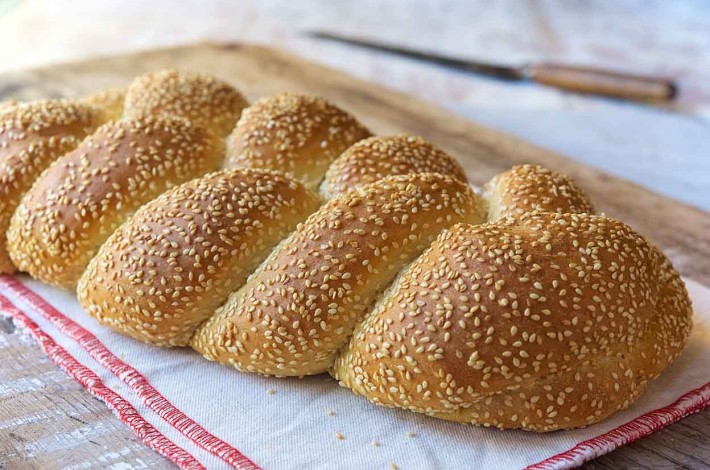


Scali bread. If you’re from Boston, you grew up with it; it was the daily bread of choice for most Italian families. And a common offering in sandwich shops, as in “Ya want that on white, wheat, rye, or scali?” Now, it’s sold at Trader Joe’s. And if you google scali, you’ll find all kinds of recipes and discussion about it.
This shiny, mahogany-brown loaf, heavily coated with nutty sesame seeds, has lots of low-key buzz surrounding it; I’d say it has good mojo. (A word to my son, Nik: if I’m using that word wrong, DON’T bother to tell me. Thank you.) And, I have a personal attachment to scali bread: it was my first “showoff” loaf, made strictly to impress someone—my new husband.
We were walking through the grocery store hand in hand (remember those days? Grocery shopping as part of the ongoing courtship ritual?), and he casually threw this seedy braid into the shopping cart—without consulting me, the designated shopping maven.
“We don’t need any bread,” I offered, thinking of the Pepperidge Farm thin-sliced sandwich loaf in the breadbox at home.
“We don’t have any bread,” he said.
“We have Pepperidge Farm,” I countered.
“That’s not bread.”
Uh…. I had no rejoinder. Pepperidge Farm, beloved companion of my childhood, not bread? Toasted bearer of butter and jam in the morning, sandwicher of PB & J at noontime, the perfect loaf for grilled cheese—NOT BREAD? I let it slide. We were newlyweds, after all, still testing the waters of potential marital discord.
Later, at home, I asked Rick what he was going to do with the scali bread. I thought there might be some strange Italian food ritual surrounding it. Like, you can ONLY eat spaghetti and meatballs with scali bread.
He looked at me strangely. “Eat it?” he ventured.
“I’m not planning on making spaghetti,” I said.
Mystified, Rick offered that scali bread was eaten with EVERY meal. Just as Pepperidge Farm was my daily companion, scali was his. He toasted it for breakfast, had sandwiches on it at lunch, and wiped his plate clean with it at dinner. Scali bread quickly earned a permanent spot on my shopping list.
And soon, I learned to make it. I was a budding bread baker, and despite its appearance, scali was pretty simple to make. I’ve since tweaked the recipe, adding an overnight starter for flavor, some milk powder for texture, but scali has remained a regular in my repertoire for over 30 years now.
Rick and I are both grayer, slower, and more creaky than we were when I first learned about scali. And we occasionally still grocery shop together, though he’s more interested in browsing the wine section than trailing me through frozen foods. I still love my Pepperidge Farm-style white bread (though I’ve learned to make my own). He still loves his scali. And we still love each other. It doesn’t get any better than that.
Here’s my tried-and-true recipe for Scali Bread.
As with many crusty artisan-style loaves, we begin by making a starter, a simple combination of flour, water, and yeast. Overnight, this gnarly little ball of dough is transformed into...
...a lovely, bubbly mass of dough.
Mix the starter with the remaining dough ingredients.
That unassuming mixture becomes a lovely, smooth, slightly sticky dough.
Set it in a greased, covered container to rise for 2 hours.
Next, spray a work surface (here I'm using a silicone rolling mat) with vegetable oil spray. I use Everbake; it's a good all-purpose spray that, when you use it on your baking pans, doesn't leave that icky dark goo that some sprays leave. Divide the dough into three equal pieces, and gently pull them into rough logs. Walk away for 10 minutes; you can leave the dough uncovered. This gives the gluten in the dough a chance to relax, which will make it easier to roll into ropes.
Gently roll the dough under your cupped fingers to make ropes about 24” long.
Paint each rope with 1 large egg white beaten with 1 tablespoon water. This “liquid glue” will make the sesame seeds adhere nicely.
Sprinkle heavily with seeds, rolling the ropes gently on the work surface to pick up as many fallen seeds as possible.
Squeeze the three ropes together at one end...
...and start to braid. Cross the left- and right-side pieces, alternating them, over the piece in the center.
Keep going, trying not to stretch the dough too much. Stretching it could result in a misshapen braid, as the gluten will want to shrink back again as the braid rises.
When you run out of rope, squeeze the ends together. Tuck both ends underneath to make a neat loaf.
Cover the braid and let it rise till it's very puffy, 1 to 2 hours.
Bake the loaf to transform it into a shiny gold, seed-studded work of art—scali bread!
Find the recipe online by clicking here: Scali Bread. And let us know any baked goods a loved one has introduced you to in the comments below!

